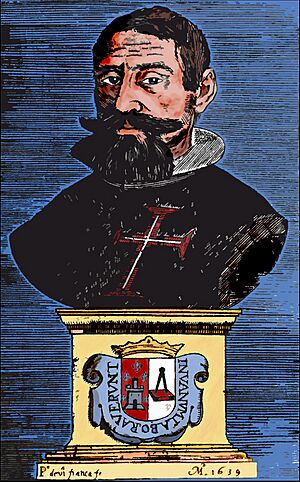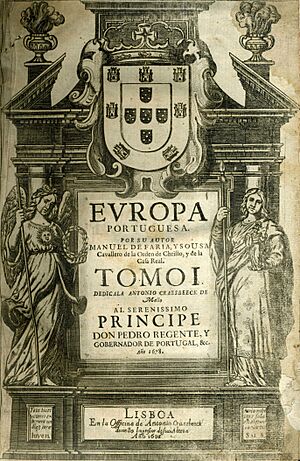Manuel de Faria e Sousa facts for kids
Manuel de Faria e Sousa (born March 18, 1590 – died June 3, 1649) was a Portuguese historian and poet. He often wrote his works in Spanish.
Manuel was born into a noble family in Portugal. He studied in Braga for a few years. After his studies, he started working for the Bishop of Porto. Most of his adult life was spent in Madrid, Spain, where he passed away in June 1649. He did spend about four years, from 1631 to 1634, in Rome as part of the Portuguese embassy.
He was married to Catarina Machado, who he called "Albania" in his poems. Their home life was quiet and focused on learning. He divided his time between his children and his many books. His first major work, Epitome de las historias Portuguezas (a summary of Portuguese history), was well-received. However, some parts of his huge notes on the famous Portuguese poem Os Lusíadas by Luís de Camões caused problems. People became suspicious, and he was held for a short time and lost his official salary. Manuel was very dedicated to his writing, supposedly writing twelve large pages every day! But he died before he could finish his biggest project, a history of the Portuguese people around the world.
Several parts of his unfinished work were published in Lisbon after his death. These were edited by Captain Faria e Sousa. They included: Europa Portugueza (Portuguese Europe, published in 1667), Ásia Portugueza (Portuguese Asia, published between 1666–1675), and África Portugueza (Portuguese Africa, published in 1681).
As a poet, Manuel de Faria e Sousa also wrote many works. His poems were collected in books like Noches claras (Clear Nights, 1624–1626) and Fuente de Aganipe (Fountain of Aganipe), which had four volumes published between 1644–1646. He also wrote Imperio de China i cultura evangelica en l (Empire of China and Evangelical Culture, 1642) based on information from P. A. Semmedo. He also translated and finished the Nobiliário (a book about noble families) by the Count of Barcelos.
Some of his historical works were later translated into English. J. Stevens translated his History of Portugal (1698) and Portuguese Asia (1695).
Major Works and Writings
Manuel de Faria e Sousa wrote many books, both history and poetry. Here are some of his most important works:
Historical Books
Manuel de Faria e Sousa is best known for his detailed historical accounts of Portugal's presence around the world.
- Epitome de las historias portuguesas (1628): This was a summary of Portuguese history. Later, it was expanded into his larger work, Europa Portuguesa.
- Lusiadas de Luis de Camoens, principe de los poetas de España. Comentadas (1639): This book contained his extensive notes and comments on the famous epic poem Os Lusíadas. He spent 25 years working on this, studying many authors.
- Imperio de la China e cultura evangelica en el (1642): A book about the Chinese Empire and the spread of Christianity there.
- Nobiliario del Conde de Barcellos D. Pedro (1646): This was a translation and completion of an older book about noble families.
- Asia Portuguesa (published 1666–1675): This three-volume series tells the history of Portugal's actions in Asia.
- Volume 1 (1666): Covers the history of India from its discovery until 1538.
- Volume 2 (1674): Continues the history of India from 1538 to 1581.
- Volume 3 (1675): Focuses on the history of India during the time Spain ruled Portugal (1581–1640).
- Europa Portuguesa (published 1678–1680): This three-volume work covers the history of Portugal itself.
- Volume 1 (1678): Goes from the great flood (in ancient stories) to the time Portugal had its own king.
- Volume 2 (1679): Covers the period from the rule of Count D. Henrique to King D. João III.
- Volume 3 (1680): Describes the time from King D. Sebastião to King Filipe III of Portugal.
- África Portuguesa (published 1681): This book tells the story of Portugal's conquests in Africa, from King D. João I up to the year 1562.
Poetic Collections
Manuel de Faria e Sousa also wrote many poems, which were gathered into collections.
- Divinas e humanas flores (Divine and Human Flowers, 1624)
- Noches claras (Clear Nights, 1624)
- Fuente de Aganipe y Rimas varias (Fountain of Aganipe and Various Rhymes, 1644, 1646): This was a large collection of his poems, written in both Portuguese and Spanish. It included many different types of poems like sonnets, songs, and short verses.
Images for kids





